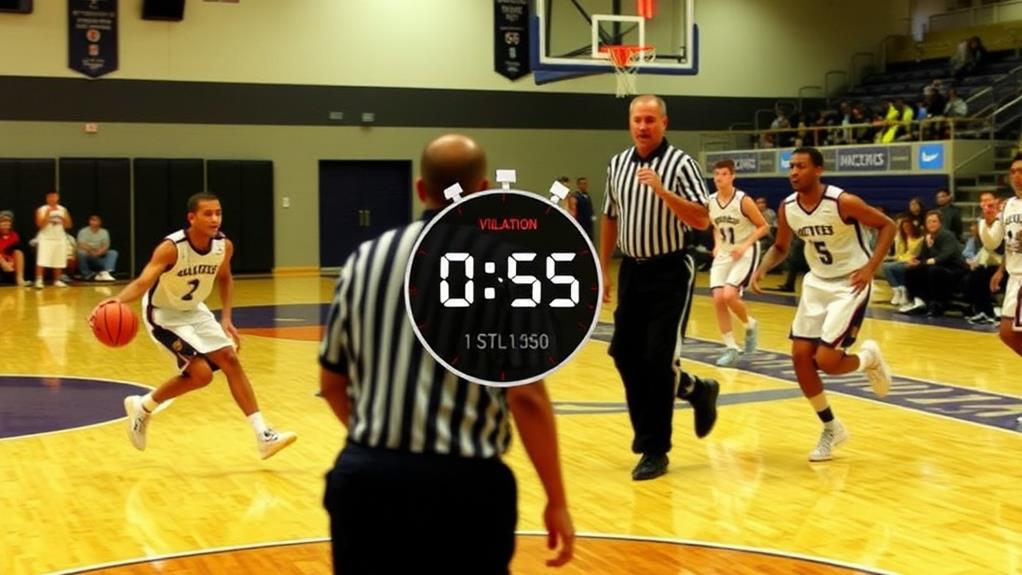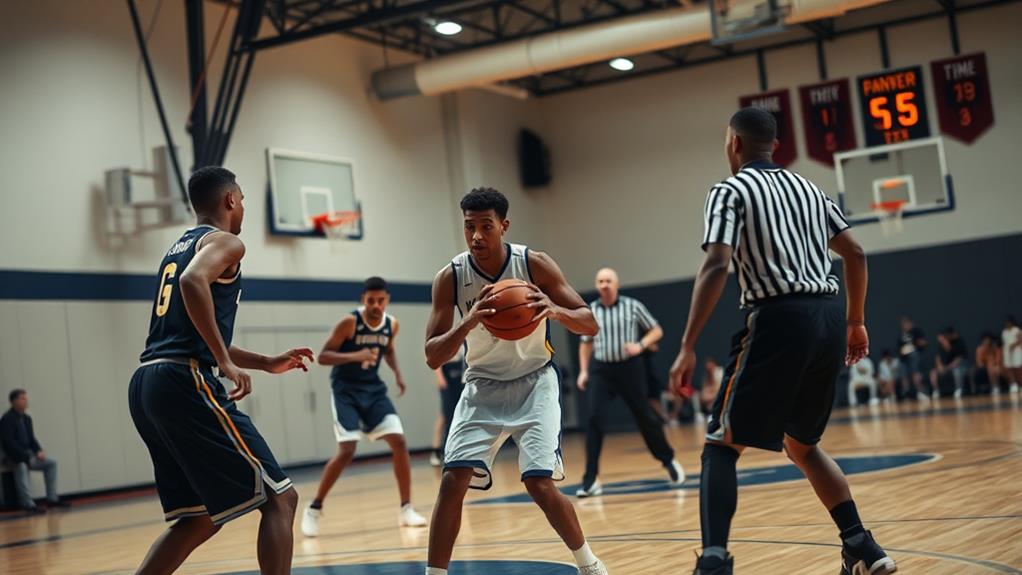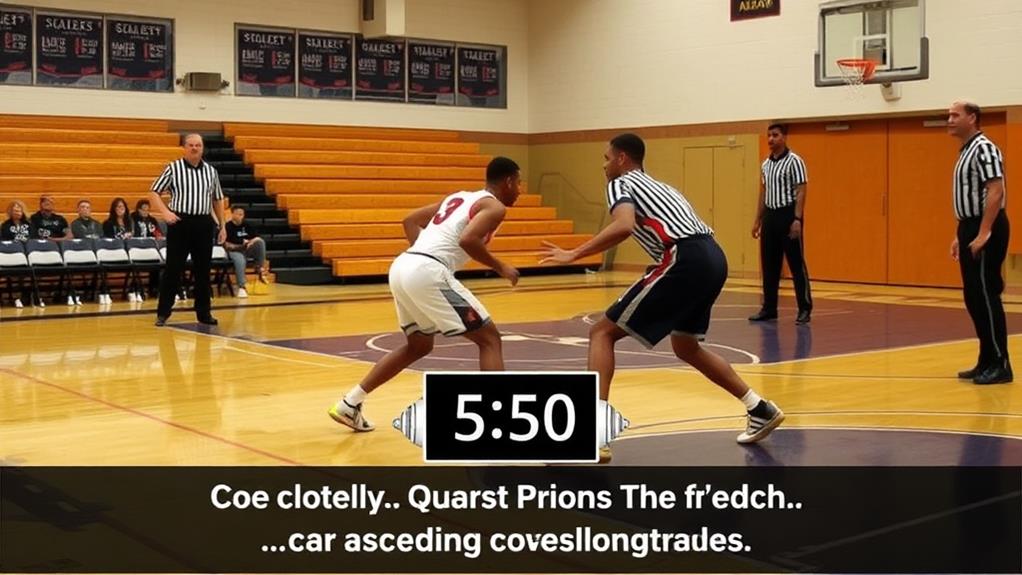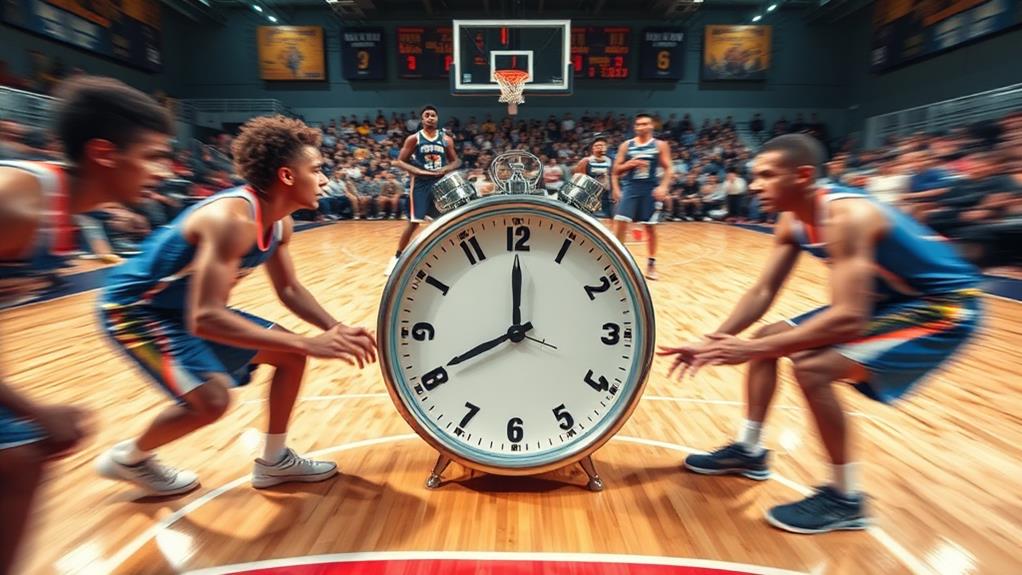
The 5-Second Rule in Basketball: What It Is and How It Works
October 12, 2024The 5-second rule in basketball requires you to pass, shoot, or dribble within five seconds when closely guarded. If a defender is within six feet (men's NCAA) or three feet (women's NCAA), the clock starts ticking. Failing to act leads to a turnover, giving possession to the other team. This rule keeps the game fast-paced and encourages quick decision-making, which can be essential in tight situations. Understanding how this rule affects your strategy will help you play smarter and more efficiently. Discovering its nuances can really enhance your game.
Definition of the 5-Second Rule
The 5-Second Rule in basketball is an essential regulation that sets a strict time limit for players when they're closely guarded or during inbounding situations. This rule dictates that an offensive player has five seconds to either pass, shoot, or dribble the ball. If you fail to make a move within this timeframe, it results in a 5-second violation, which leads to a turnover.
In the case of inbounding, after receiving the ball from the referee, you must inbound it within five seconds. If you don't, your team loses possession of the ball.
When being closely guarded, defined as a defender being within six feet in NCAA men's basketball or three feet in NCAA women's basketball, you must also act quickly. This regulation promotes quick decision-making and maintains the flow of the game much like team composition regulations in soccer. The rule in basketball is designed to keep the game fast-paced and prevent stalling.
Additionally, if you're dribbling with your back or side to the basket, you can't do so for more than five seconds; this is known as a 5-Second Back to the Basket Violation.
Violating any aspect of this rule results in the opposing team gaining possession of the ball at the spot of the violation.
Types of 5-Second Violations
Understanding the different types of 5-second violations is essential for players and coaches alike. Each of these violations can lead to a turnover, affecting your team's performance. As basketball strategies evolve, awareness of defensive tactics becomes increasingly important, especially in relation to modern defensive demands.
Here are the three primary types:
- Throw-In Violation: This occurs when a player with the ball fails to inbound it within five seconds after receiving it from the official.
- Closely Guarded Violation: This happens when an offensive player holds the ball for five seconds while being closely guarded, defined as a defender being within six feet in NCAA men's rules.
- Back to the Basket Violation: This violation applies in the NBA, where a player with the ball can't dribble while facing away from the basket for more than five seconds; it's often referred to as the "Charles Barkley rule."
Each type of five-second violation results in a deadball turnover, awarding possession to the opposing team at the location of the violation.
Being aware of these rules helps you avoid costly mistakes and keeps your team in the game. Remember, staying aware of your surroundings can prevent these violations!
Purpose of the 5-Second Rule

The 5-Second Rule plays a crucial role in enhancing game flow by pushing players to make quick decisions on the court.
This rule encourages teams to develop efficient play creation for high percentage shots while also speeding up offensive plays, which can lead to better scoring opportunities.
It also encourages defensive teams to stay engaged and apply pressure.
Enhancing Game Flow
A crucial aspect of basketball, the 5-second rule greatly enhances game flow by encouraging quick decision-making among offensive players.
By imposing a time limit during closely guarded situations and inbounding, it prevents stalling and keeps the action moving. This not only promotes a faster pace of play but also guarantees that teams remain engaged and competitive.
The five-second rule contributes to game flow in several key ways:
- Encourages offensive players to make swift decisions, reducing time-wasting tactics.
- Increases the effectiveness of defensive strategies by applying constant pressure.
- Maintains continuous action, engaging both players and spectators.
- Promotes a balanced environment where teams must adapt to each other's strategies.
- Fosters excitement and fluid gameplay, making each possession critical.
Promoting Quick Decisions
In basketball, quick decision-making is essential, and the 5-Second Rule plays an important role in fostering this skill. When you're closely guarded, you have just five seconds to act before you face a 5-second closely guarded violation. This rule pushes you to make quick decisions, whether it's passing, shooting, or dribbling. If you find yourself holding the ball too long, you risk a turnover, which can shift the momentum of the game.
By limiting the time you can spend with the ball, the 5-Second Rule encourages active ball movement and teamwork. You're forced to think strategically and adapt to the pressure applied by the defensive player. This not only helps you develop your skills but also keeps the game exciting and dynamic.
Moreover, the rule rewards effective defensive play. When defenders apply pressure, they create opportunities for turnovers if you hesitate. Understanding and adhering to the 5-Second Rule enhances your ability to make quick decisions under pressure, ultimately improving your performance on the court.
Embrace this challenge, and you'll see your game elevate to new heights.
Encouraging Defensive Engagement
While closely guarded, you must act quickly, and that's where the 5-Second Rule shines by encouraging defensive engagement. This rule creates an environment where defenders can apply pressure, forcing offensive players to make faster decisions with the control of the ball. By limiting the time to five seconds, your opponent can't just hold onto the ball and wait for an opportunity; they've to react.
Here are some key aspects of how the 5-Second Rule promotes defensive engagement:
- It mandates that a defender stays within six feet (NCAA men's) or three feet (NCAA women's) of the offensive player.
- The time constraint rewards effective defensive tactics, allowing defenders to force turnovers.
- It keeps both teams actively involved, preventing stalling in the game.
- Defensive players have the chance to disrupt plays, creating opportunities for their team.
- The rule fosters a competitive balance, ensuring that neither offense nor defense dominates the game.
Ultimately, the 5-Second Rule enhances gameplay by stimulating dynamic interactions between players, making every second count. Embrace the challenge it brings to both offense and defense!
Penalties for Violations
Penalties for violations in basketball often lead to vital shifts in the game. Just like the importance of discipline in soccer, adhering to the rules in basketball is essential for maintaining team strategy and momentum.
When you commit a five-second closely guarded violation, your team loses possession, and the opposing team gets the ball from the nearest out-of-bounds spot. Similarly, if you're called for a back to the basket violation, and you dribble with your back or side to the basket for more than five seconds, it results in a turnover, granting possession to the opposing team.
Throw-in violations can also be costly. If you fail to throw the ball in within five seconds, it leads to a turnover, giving the other team possession at the previous out-of-bounds spot. These violations disrupt your team's offensive flow and can shift momentum greatly in favor of the opposing team.
In FIBA, free throw violations require shooters to attempt their free throw within five seconds; otherwise, the shot doesn't count, and possession is awarded to the opposing team at the free throw line extended.
Understanding these penalties is vital, as they can greatly impact the outcome of a game.
Closely Guarded Rule Variations

Understanding the variations of the closely guarded rule is essential for players at different levels of basketball. Knowing these differences can help you stay aware of your surroundings and avoid violations during the game. Additionally, being proficient in passing techniques can greatly enhance your ability to move the ball and avoid being closely guarded.
In NCAA men's basketball and high school, the rule states that a defender must be within six feet of you to initiate the five-second count. Here are some key points to keep in mind:
- In NCAA women's basketball, the defender must be within three feet.
- The five-second count applies only when you're holding the ball in NCAA men's rules, not while dribbling.
- In high school basketball, the count can occur while you're dribbling.
- If you create distance from the closely guarded defender, the count resets.
- The five-second rule is enforced anywhere on the court in NCAA women's games.
Being aware of these variations can give you a competitive edge and help you make better decisions on the court. Always keep an eye on your defender's position and be ready to move if you're getting too close to that five-second mark!
Teaching Players to Avoid Violations
To help your team avoid violations, focus on effective inbounding strategies that keep the ball moving.
Utilizing data-driven strategies can enhance player awareness and decision-making during high-pressure situations.
You should recognize defensive pressure and respond quickly, ensuring players are ready to make decisions under pressure.
Effective Inbounding Strategies
Effective inbounding strategies are essential for maintaining possession and preventing violations in basketball. When you're the inbounder, you need to be strategic to avoid the dreaded five-second violation.
Here are some effective techniques to guarantee a smooth inbounds process:
- Always have a designated safety outlet player ready to receive the throw-in.
- Be aware of the referee's hand signals to effectively manage your time limit.
- Encourage teammates to set screens or move away from you to create space.
- Communicate clearly by calling out plays or signals to indicate your movements.
- Practice various inbounding scenarios so players are familiar with their options under pressure.
Recognizing Defensive Pressure
When inbounding the ball, recognizing defensive pressure is key to avoiding violations like the five-second rule. You need to be aware of your surroundings and know when a defender is within the specified distance—six feet for NCAA men and three feet for NCAA women. If a defender is closely guarding you, you've got just five seconds to make a move.
To evade defensive pressure, practice using effective screens and cuts. These tactics can help create space and reset your five-second count. If you stay fluid in your movements, you'll have a better shot at finding an open teammate or making an effective pass.
Additionally, communicate consistently with your teammates. By doing this, you can identify passing options and reduce the chances of being trapped.
Always look for a reliable outlet receiver as a safety valve to minimize the likelihood of throw-in violations.
Quick Decision-Making Skills
Quick decision-making skills are essential for players to avoid costly violations like the five-second rule. When you're holding or dribbling the ball, you need to act fast, especially when you're guarded closely.
Here are some strategies to enhance your quick decision-making:
- Simulate game scenarios: Practice evaluating passing, shooting, or dribbling options within five seconds.
- Always have an outlet: During inbound situations, confirm you've got a teammate ready to receive the ball quickly.
- Incorporate rapid movement drills: Focus on spacing and positioning to create opportunities for evading defenders.
- Watch the referee: Stay alert for hand signals that indicate the start of the five-second count.
- Communicate effectively: Foster strong communication with teammates to facilitate quick decisions in high-pressure moments.
Impact on Game Strategy

The 5-second rule considerably shapes game strategy in basketball by compelling offensive players to act swiftly. This rule encourages quick decisions, enhancing team play and reducing the chances of turnovers from stalling. Coaches design offensive strategies that prioritize rapid ball movement and player movement to avoid the closely guarded count, keeping the offense dynamic and effective.
Additionally, the evolution of offensive strategies, such as the pick-and-roll's significance, further emphasizes the need for swift execution in the game. Utilizing picks and screens becomes essential, as they create space and reset the 5-second count, opening up scoring opportunities.
When you understand the 5-second rule, you can anticipate defensive movements, which helps with better positioning and shot selection during high-pressure moments. This anticipation allows your team to exploit defensive lapses and create high-quality shots.
Furthermore, the rule underscores the necessity of having capable shooters on the floor. Quick passing and shooting prevent the offense from becoming stagnant, keeping the pace lively and reducing the risk of violations.
Fundamentally, the 5-second rule not only influences individual player actions but also molds the overall game strategy, ensuring that teams remain aggressive and responsive on the court.
Resources for Players and Coaches
Understanding the 5-second rule isn't just about grasping its impact on strategy; it also involves knowing where to find the right resources to enhance your skills and knowledge.
Both players and coaches can benefit from a variety of educational materials designed to deepen their understanding of this essential rule. For instance, coaches can explore tutorials on tactical analysis to better instruct their teams on decision-making under pressure.
Here are some valuable resources you should consider:
- NBA Rulebooks: Access the official guidelines online to learn about the 5-second rule's applications.
- Coaching Clinics: Many basketball organizations offer clinics that focus on avoiding 5-second violations.
- Drills and Scenarios: Utilize practice materials that help players develop quick decision-making skills.
- Video Content: Look for videos with closed captioning to improve comprehension, especially for individuals with hearing impairments.
- Online Forums: Engage with community discussions to share insights and experiences regarding the 5-second rule.
Conclusion
So, next time you think about holding the ball for more than five seconds, remember—you're not auditioning for a statue role! The 5-second rule isn't just a suggestion; it's a game-changer. Embrace the hustle and keep that ball moving, unless you want to see the referee's arm signal your demise. After all, no one wants to be the player who makes "standing still" the latest trend in basketball. Let's keep the game lively and entertaining!


